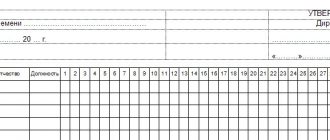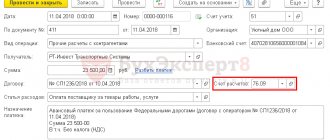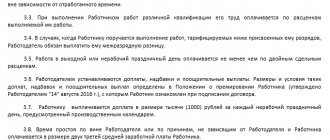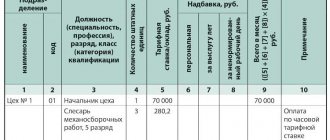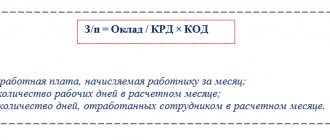Salary
Victoria Pechieva
Expert, chief accountant with 12 years of experience
Current as of October 21, 2019
Piecework wages are a form of salary that directly depends on the amount of products produced by an employee or the amount of work performed by him. There are several types of piecework wage systems. Let's look at the calculation of earnings for each of them using examples.
Types of piecework wages
Piece wages are a form of remuneration that is introduced with the aim of stimulating workers to produce a larger volume of production in the allotted time. In this case, the main indicator for calculating an employee’s income is the quantity of products produced (services provided, work performed).
We do not recommend establishing piecework payment in industries that require increased concentration of attention from the employee, since the pursuit of increasing the number of products produced can lead to a large number of defects.
The following types of piecework wages are distinguished:
The employer has the right to approve several remuneration systems at one enterprise for each position, department, etc. For example, for the administration - time-based, for the sales department - commission, for the production department - piece-rate bonus. See also “Time-based wage system is.”
Advantages and disadvantages
The main advantage of piecework payment is the employer’s ability to increase labor productivity by introducing incentives for employees (for example, increasing tariffs), and the disadvantage is the possible loss in the quality of products or services due to increased output.
The use of this form of payment is inappropriate if it is impossible to increase the quantitative indicators of production under the conditions of current technological standards or safety requirements.
According to Art. 160 of the Labor Code of the Russian Federation, when introducing a piecework payment system at an enterprise, the employer is obliged to establish a daily or hourly production rate and corresponding payment rates. Part 2 art. 22 of the Labor Code provides for the employer’s obligation to provide employees with a sufficient amount of work as specified in the employment contract. It should also set out the conditions for calculating wages (Article 57 of the Labor Code of the Russian Federation).
The presence of a piece-rate form of payment at an enterprise is fixed by a collective agreement and other regulations corresponding to the legislation.
When performing any operations, the accountant is required to record wage entries in a special journal or enter data into a computer database. Sick leave for pregnancy and childbirth is paid to workers, students and the unemployed who are registered with the employment center. Read more about calculating sick pay here.
A special form is used to calculate the average salary. You will find a detailed explanation, as well as examples, in the article.
Direct piecework wage system
It is approved, as a rule, by production employees, for whom work standards can be set. For example, time or production standards.
In this case, earnings are calculated based on the number of products manufactured and the prices set by the employer.
The formula for calculating income is as follows:
The piece rate per unit of production can be determined in several ways, for example:
- multiplying the hourly (daily) tariff rate by the hourly (daily) time standard;
- dividing the hourly (daily) tariff rate by the hourly (daily) time standard.
Example 1
Masterok LLC has established a piecework wage system for workshop employees. For the production of one part, a rate of 1,000 rubles is provided. An employee produced 44 parts in September 2021. His earnings amounted to 44,000 rubles. (44 units × 1,000 rub.)
Such a system encourages the employee to increase the volume of output, but he is not interested in the quality of the parts produced. To motivate employees to produce products without defects, employers are introducing piecework-bonus wages.
Pros of the transition
The payment system under consideration has several positive aspects for the employee and for the employer. Among them:
- wages are comparable to production;
- the salary per unit of output is equal to the knowledge and skills of the employee;
- awarding bonuses and other methods of motivation for reworking the plan;
- control, maintaining the quality of worker’s work at a high level (with correctly calculated standards).
It is worth considering that despite the visible advantages of the system, the manager must clearly understand when it is appropriate to make the transition to new forms of calculating salaries and bonuses.
Piece-progressive wage system
It is used to encourage employees to produce as many products as possible in excess of production standards. Products manufactured by an employee in excess of production standards are paid at increased piece rates.
It is advisable to use this system when you need to quickly increase production volumes. Therefore, it is used quite rarely and for a short time (usually no more than 6 months).
With such a remuneration system, additional bonuses may be provided.
Salary under the piecework-progressive system is calculated according to the formula:
Earnings for products produced within the norm are calculated by multiplying the piece rate within the norm by the number of products manufactured within the norm. And the salary for products in excess of the norm is by multiplying the increased price by the number of products produced in excess of the norm.
Example 3
Let's change the conditions of example 1 and assume that Masterok LLC has installed a piece-rate progressive wage system. The norm is 35 parts per month. The price for each part is RUB 1,000. For exceeding the norm - 1,300 rubles. The accountant calculated the employee’s earnings in several steps:
- income within normal limits - 35,000 rubles. (35 units × 1,000 rub.);
- salary above the norm - 11,700 rubles. ((44 units - 35 units) × 1,300 rub.);
- Semenov’s total income for September is 46,700 rubles. (35,000 + 11,700).
Negative aspects of the system
Like any economic phenomenon, this system also has its disadvantages.
Negative aspects for the employer:
- complexity of administration, which should be understood as the need to maintain a staff of controllers and accountants (this puts an additional burden on the wage fund);
- a possible decrease in the quality of work, since the employee may be focused not on the quality of the work performed, but on its quantity (the need for strict control of defects);
- the level of injuries is higher than under normal conditions (the employee, in pursuit of the volume of work, loses attentiveness and concentration);
- complexity of the labor standardization process.
Negative aspects for employees:
- The “ratchet” effect suggests that an increase in the volume of work performed entails an increase in standards. With a constant increase in standards, the employee’s capabilities are at the limit, he ceases to cope and, as a rule, loses interest in productive work.
- Reduced income when going on vacation or sick leave.
Indirect piecework wage system
This system is used to pay support staff, for example, workers who set up equipment. Their income depends on the output of key workers. This system is used to encourage support staff to provide better services to key workers.
The law does not provide for a single formula for calculating wages under an indirect piecework wage system. The employer can develop and approve its own options.
We'll look at a few possible examples.
At indirect piece rates
The formula for calculation will be as follows:
Example 4
A. M. Grigoriev works at Masterok LLC, who prepares blanks for A. Yu. Semenov for processing manufactured parts. Grigoriev’s daily rate is 1,400 rubles. Semenov’s monthly production rate is 35 parts, but in fact Semenov produced 44 parts.
Grigoriev’s indirect piece rate per shift: 1,400 rubles. / 35 children = 40 rub.
Since Semenov exceeded the plan, Grigoriev’s daily earnings increased:
40 × 44 children. = 1,760 rub.
Grigoriev worked 22 shifts in September. His income was 38,720 rubles. (22 × 1,760 rub.)
Using the average compliance rate
The formula in this case:
INCENTIVE PAYMENTS
Incentive payments are additional payments and bonuses of an incentive nature, as well as bonuses and other incentive payments. To best motivate the work of employees, enterprises develop appropriate bonus provisions (features of providing incentive and incentive payments can be specified in the collective agreement or regulations on remuneration).
The provision standards or amounts of payments are not regulated at the legislative level, therefore the enterprise has the right to independently establish the appropriate additional payments (fixed monetary form/percentage of the official salary or tariff rate).
That is why, and in order to increase the stimulating value of remuneration, piece-rate and time-based wage systems are used in combination with bonuses for employees for meeting and exceeding their performance indicators (piece-rate and time-based bonus).
The bonus provision may provide for other one-time payments:
- in connection with state or professional holidays, significant or anniversary dates;
- for high individual achievements in work, active participation in the activities of the organization, etc.
Since there are no restrictions on material incentives for employees by law, bonus provisions can be established :
- individual bonuses to tariff rates or official salaries (for high achievements in work, high qualifications, etc.);
- allowances for training of newly hired employees or for continuous work experience in the organization.
In order to prevent negativity from the workforce in the event of non-payment of bonuses due to the lack of opportunity at the enterprise, it is worth writing the following in the appropriate section of the bonus regulations: “Bonuses are paid to the organization’s employees if there are available funds that can be spent on material incentives without compromising the main activities of the organization.
Chord system of remuneration
As a rule, it is installed for individual teams if it is necessary to reduce the time required to complete the work. Employees are paid for performing a certain set (volume) of work according to a unit assignment, and not individual operations or types of work.
The entire list of works included in the chord task, their volume, time standards (production), prices, total cost and deadline for completing all work are established in advance. Payment is distributed among employees, for example, as follows: based on the time worked by each of them, in accordance with the labor participation rate.
The lump sum wage system can be used for construction work, emergency response, and repair of machinery and equipment.
Example 6
The team consists of 5 people. A contract assignment for the construction of utility premises for Sfera LLC was received in the amount of RUB 250,000. The brigade completed the task in a month. The amount of earnings was distributed in proportion to the time worked:
| Workers | Time worked | Amount to be received (RUB) | Calculation |
| 1 employee | 23 days | 59 895,83 | 250 000 / 96 × 23 |
| 2 employee | 20 days | 52 083,33 | 250 000 / 96 × 20 |
| 3 employee | 25 days | 65 104,17 | 250 000 / 96 × 25 |
| 4 employee | 18 days | 46 875,00 | 250 000 / 96 × 18 |
| 5 employee | 10 days | 26 041,67 | 250 000 / 96 × 10 |
| Total | 96 days | 250 000 |
Employees need to be paid wages at least every half month (Article 136 of the Labor Code of the Russian Federation). It is prohibited to pay the entire salary amount in one lump sum after completing the work.
With such a system, additional bonuses may be provided. The bonus is paid in accordance with the employer's bonus system (for example, for reducing the deadline for completing a task, subject to high-quality work).
Calculation
The rules for calculating piecework wages should be regulated by a local act of the enterprise, available for review by pieceworkers. In general, the formula for calculating the salary due to such an employee is as follows:
ZP = Kp * Sed, where
- ZP – salary before taxes;
- Кп – number of released (manufactured) units of product;
- Sed – prices for 1 unit of finished product.
The formula will look more complicated if the employer expects to pay a bonus for fulfilling or exceeding the plan:
ZP = Kp * Sed + P, where
- P is a bonus based on the results of work, which is often fixed, but may also depend on the number of products produced in excess of the norm.
With progressive calculation, the formula will be even more complicated:
ZP = Kp * Sed + Kpp * Sedp, where
- KPP – quantity of products in excess of the established fee;
- Sedp is the increased cost of products established after fulfilling the established norm in a certain time period.
If a local act provides for more than one progressive increase in the cost of production, then there will be even more terms in the formula.
The specific calculation formula depends on the specifics of calculating piecework wages established by the relevant Regulations at the level of a particular organization.
Commission pay
Such a remuneration system is usually used in relation to workers involved in the sale of goods and services: sales managers, store clerks, advertising and marketing specialists, in order to encourage them to increase sales volume, sell products (work, services) to the maximum volumes.
In a commission system of remuneration, earnings are determined as a percentage of sales or revenue received by the organization. At the same time, regardless of the volume of sales or revenue, the monthly earnings of an employee who has fully worked the standard working hours for a given period cannot be lower than the minimum wage (Part 3 of Article 133 of the Labor Code of the Russian Federation).
We remind you: from January 1, 2019, the minimum wage is 11,280 rubles. And from 01/01/2020 - 12,130 rubles. Regions have the right to set their own minimum wage, but it cannot be lower than the values given above.
Salary can be calculated in various ways - it can be:
- fixed percentage of revenue;
- salary with additional payment in the form of a fixed percentage of the amount of revenue;
- a fixed percentage of the difference between the sales price and the cost of products (works, services).
Example 7
Sellers at the Severny store are paid 1% of their monthly revenue. In September, the revenue amounted to 2 million rubles. The salary of each seller was 20,000 rubles. (RUB 2,000,000 × 1%).
COMPENSATION PAYMENTS
Compensation payments are designed to compensate for work under conditions that deviate from normal conditions. Compensation payments include:
- payments to employees engaged in heavy work, work with harmful, dangerous and other special working conditions;
- for work in areas with special climatic conditions;
- for work in conditions deviating from normal (overtime, night work, combining professions, expanding service areas, increasing the volume of work or performing the duties of a temporarily absent employee without release from work specified in the employment contract, for working on weekends and non-working holidays days and when performing work in other conditions deviating from normal).
According to Art. 147 of the Labor Code of the Russian Federation, remuneration for workers engaged in work with harmful and ( or ) dangerous working conditions is established at an increased rate. The minimum increase in wages for employees engaged in work with harmful and (or) dangerous working conditions is 4% of the tariff rate (salary) established for various types of work with normal working conditions. The specific amounts of wage increases are established by the employer, taking into account the opinion of the representative body of employees.
Remuneration for work in areas with special climatic conditions is made in the manner and amounts not lower than those established by labor legislation and other regulatory legal acts containing labor law norms.
According to Art. 150 of the Labor Code of the Russian Federation, when an employee with a time wage performs work of various qualifications, his work is paid for work of a higher qualification .
If an employee with piecework wages performs work of various qualifications, his work is paid according to the rates of the work he performs .
IT IS IMPORTANT
In cases where, taking into account the nature of production, workers with piecework wages are entrusted with performing work that is charged below the grades assigned to them, the employer is obliged to pay them the difference between grades.
With the written consent of the employee, he may be assigned to perform, during the working day (shift), along with the work specified in the employment contract, additional work in a different or the same profession (position) for additional pay.
Payment terms are stipulated in Art. 151 of the Labor Code of the Russian Federation, however, the specific level of additional payment is not regulated, so the enterprise, represented by management, can independently set the amount of additional payment: both in a fixed form and as a percentage of the tariff rate or official salary.
Carrying out the work of a temporarily absent employee (business trip, sick leave, vacation, etc.) and receiving additional payment for performing work additional to the main job responsibilities can not only be temporarily transferred to one person, but also distributed among several employees.
Employees performing the duties of temporarily absent employees are recommended to establish such an additional payment so that in total it does not exceed the level of wages of the temporarily absent employee. Otherwise, the combination becomes economically infeasible.
NOTE
The working time sheet does not keep records of combined positions, therefore, to establish the actual time worked in a combined profession, data is taken from the employee’s main profession.
HR departments should carefully study job descriptions. The instructions may indicate that the deputy head of a department acts as the head of the department during his absence. In this case, additional payments are not mandatory; the final decision on them is made by the head of the enterprise.
EXAMPLE 2
Engineer Ivanov I.I. (salary - 35,000 rubles) for a full working month performed additional work to combine the position of temporarily absent engineer Petrov N.S., whose salary was set at 35,000 rubles.
For performing additional part-time work, Ivanov is given an additional payment of 30% of the official salary of engineer Petrov.
Taking into account the additional payment, Ivanov I. I.’s salary will be:
35,000 rub. + (RUB 35,000 × 30%) = RUB 45,500 .
EXAMPLE 3
Engineer Ivanov I.I. with a fixed salary of 35,000 rubles. Over the course of an incomplete working month, he performed additional work to combine the position of temporarily absent engineer N.S. Petrov with the established salary (RUB 35,000). He was hired to carry out work on the 15th.
For performing additional part-time work, Ivanov is given an additional payment of 30% of the official salary of engineer Petrov.
Additional Information:
- number of working days in a month - 22;
- the number of days actually worked in the combined position is 11 (according to the working time sheet).
Employee Ivanov I.I. will receive the following salary, taking into account additional payments:
35,000 rub. + (35,000 rub. / 22 days × 11 days × 30%) = 40,250 rub .
Overtime pay
Overtime work is paid for the first two hours of work at least one and a half times the rate, for subsequent hours - at least double the rate (Article 152 of the Labor Code of the Russian Federation). Specific amounts of payment for overtime work can be established by a collective and labor agreement, and local regulations.
At the request of the employee, overtime work, instead of increased pay, can be compensated by providing additional rest time, but not less than the time worked overtime.
EXAMPLE 4
Mechanic Ivanov S.I. was involved in overtime work due to the temporary absence of another employee. Let's calculate the amount of wages for Ivanov, provided that the hourly tariff rate according to the enterprise tariff schedule for a mechanic is 250 rubles , and the working week is set at 40 hours with an 8-hour working day (Saturday and Sunday are days off). Ivanov S.I. is involved in working overtime for 4 hours twice per calendar month - a total of 8 working overtime hours.
Additional Information:
- number of working days in a month - 22;
- the number of hours actually worked is 184 hours , including 8 hours (data from the time sheet).
Let's calculate the salary of Ivanov S.I.
1. Wages excluding overtime:
(184 hours – 8 hours) × 250 rub. = 44,000 rub .
2. Payment for overtime work (according to the internal regulations of the enterprise and the Labor Code of the Russian Federation: the first two hours - at one and a half times; subsequent ones - at double):
(2 hours × 250 rub. × 1.5) × 2 days. + (2 hours × 250 rub. × 2) × 2 days. = 3500 rub .;
3. Amount to be charged:
44,000 rub. + 3500 rub. = 47,500 rub .
Documentation of wages under the piecework system
To record production and volumes of work performed, you can use unified forms:
- piecework work order,
- statement of work performed,
- route sheet,
- and so on.
The employer has the right to independently develop accounting forms. At the same time, it is important to comply with the requirements for primary documents approved by Art. 9 of the Law of December 6, 2011 No. 402-FZ “On Accounting”. The primary must include:
- document's name,
- Date of preparation,
- company name (full name, individual entrepreneur),
- salary calculation,
- sum,
- responsible persons of the organization,
- signatures of responsible persons.
All documents you use must be attached to the enterprise's accounting policies.
Concepts inextricably linked with the word “piecework”
Production rate is the number of units of product established by the company that must be produced within a certain period of time. Usually they talk about hourly, daily and monthly norms.
Tariff rate (salary) is the minimum guaranteed monthly wage for a given level of qualification. Specified in the employment contract. The salary is only part of the salary, which, in addition to the salary, may include all kinds of bonuses and social benefits.
The price is the amount of earnings for one unit of work performed or products produced. It is calculated through the ratio of the tariff rate to the production rate.
Tariff schedule - tariffication of wages based on the complexity of the work and the qualifications of the employee. There are ranks or categories (for example, engineer of the first category or piece worker of the 5th category).
Indicators for bonuses
With the specified system of calculating remuneration for work, the employee is guaranteed a tariff (salary) part of the monetary security in an amount proportional to the time he worked. The second part of the salary - the bonus - depends on the efforts and efforts of the employee himself. It is not an indispensable payment, since it directly depends on the requirements for bonuses recorded in the relevant documents. Such conditions may be:
- plan overfulfilment;
- achieving the established quantitative indicator;
- strict compliance with or reduction of required deadlines;
- absence of complaints, violations, complaints;
- compliance of manufactured products with certain quality criteria.
Fulfillment of these conditions can be both personal and collective.
ATTENTION! Compliance with the regulated conditions must be ensured during a predetermined period, after which results are summed up and remuneration is paid. Usually this is a month, but nothing prevents the employer from setting any convenient time period.
However, the occurrence of documented conditions is a mandatory basis for calculating the declared bonus, since it forms part of the salary package. If the employer unlawfully refuses to pay the due bonus, the employee has the right to complain and demand payment of legal remuneration for his work.
What is it and where is it used?
With a piecework-bonus wage system, the salary depends only on the volume of work performed by the employee.
It takes into account only the quantity and quality of services provided or goods produced. This type of payment is used in times of economic crisis or production stagnation, as it is beneficial for the enterprise: employers have a chance to increase the efficiency of employees, and therefore increase labor productivity, and also reduce direct costs.
Employees who exceeded the work plan, saved consumables, and completed the work efficiently may be paid a bonus at the discretion of their superiors.
Basically, piecework-bonus payment is introduced at enterprises engaged in the production of material goods and valuables. Workers perform cyclical identical operations, and with this type of salary, production downtime is excluded. In creative activities, such a practice is more likely to cause harm than benefit, because what is important is not the quantity of work performed, but its quality.
The employer should know that despite the lack of salary for employees, wages must be no less than the minimum established in the Labor Code of the Russian Federation.
When is it appropriate to use time-based bonus payment?
Like simple “time work,” this method of organizing the payment of remuneration is established when the enterprise does not have the opportunity to clearly correlate labor results with time worked, that is, standardization is difficult for objective reasons. This situation is created in many professional fields, for example, in education, management, many production processes, etc. The time-bonus regime is convenient because, in addition to all the advantages of time-based wages, it includes additional benefits of bonuses.
- The undoubted advantage of this salary system for the employer is that due to the linking of labor remuneration with quantitative and qualitative factors, personnel are encouraged to increase labor efficiency.
- This system is very simple in calculations and understandable to employees even on an intuitive level, so that staff can easily understand what factors influence the size of their wages, which stimulates additional interest in the results of their work.
- The organization of labor is improved, since the employee is directly interested in saving labor resources, which may be lost on unproductive operations (this point is not taken into account with simple time-based payment).
- There is a growing need for workers to treat equipment with care.
CONCLUSION: the time-based bonus system, due to its flexibility and ease of application and control, is a very effective tool for organizing remuneration, especially in combination with other forms of personnel incentives.
How to install in an enterprise
In order to implement piecework-bonus wages in a company, you need to complete 3 main steps.
Preparation
During this stage, the company's management will need to take the following actions:
- Analyze the company’s objectives, as well as employee motivation.
- Accurately and objectively determine the results of employees’ work over the last period, and raise the question of how satisfying and sufficient they are for the development of the organization. If it is necessary to monitor the progress of work, a control system is introduced.
- Prepare a plan for the development of the organization, setting profit goals. Calculation of the quantity of necessary goods and services produced by employees.
- Making a decision on the need to introduce piecework-bonus wages. Setting wages for the production of one conventional unit of goods, agreement with management.
- Establish fixed and variable components in employee salaries.
- Finding out the factors that influence the company’s profit and depend only on the activities of employees. At this stage, it is possible to maintain the control system mentioned in paragraph 1.
- Select an example of a similar company with piecework-bonus wages as a guide.
- Develop a remuneration system: a mechanism for calculating bonuses and fines, fixed and variable parts.
- Check the developed payment system:
- establish a correspondence between the employee’s payment for one unit of goods/services and the company’s revenue plan;
- transparency of salary payments;
- identifying risks in case of employees abusing their opportunities for unlimited income;
- checking the growth of professionalism of workers and improvement of production technology.
Introduction
After completing the first step, the company's management will have to:
- Discussion and agreement of this type of remuneration with all departments of the organization, with employees, as well as with lawyers and accountants.
- Introduction of changes after the first few (test) months of work.
- Preparation of the necessary documents for the official implementation of the new payment system, determining the date from which it will come into force.
- Holding a general meeting with employees, where all the details of the system, their benefits and motivation will be explained to them. Management must take this issue seriously and cover all the details and features in as much detail as possible, otherwise piece-rate payment will not be so effective.
- Drawing up orders for the transition to new wages, drawing up work orders and employment contracts for employees.
- Official launch of the system.
Direct use
While working with this system, management will need to:
- Maintain feedback with all departments of the organization and directly with the employees themselves, hold meetings during which to discuss emerging problems, and then make the necessary adjustments.
- Try to communicate with employees as much as possible, find out from them all the pitfalls of such remuneration.
- Monitor the implementation of the revenue plan, make necessary adjustments to employee salaries or the number of standard hours.
- Constantly be interested in new trends in the labor market and innovations in remuneration systems.
You can learn how to motivate employees with piecework wages from this video.
Algorithm for calculating piecework wages with formulas and examples
The piecework form of wage calculation is used where the specifics of economic activity make it possible to determine the relationship between an employee’s salary and the volume of work performed (services provided) or the volume of products produced by him.
- piecework pricing carried out for a specific type of work based on a price rate corresponding to the category of work (not to be confused with the category of the employee);
- the norm of produced products, which is an indicator of the fulfillment of approved norms for a specific unit of time.
- time standard indicating the established time period during which a unit of product is manufactured (work, services). To accurately determine time parameters, the timing method is used. Using this method, the time spent on movements and actions during production operations is determined.
An example of salary calculation for a time-based bonus system
The Inspiration SPA salon has a time-based bonus wage system. The bonus regulations state that all employees are entitled to a 25% increase in salary if the salon's total monthly revenue reaches or exceeds a certain figure. Master massage therapist with a monthly salary of 8 thousand rubles. out of 25 working days in a month, he worked 22. The profit of the salon in the accounting month reached good levels, giving grounds for bonuses. Let's calculate how much a master massage therapist will receive this month.
It is important to know: Is the wage clause mandatory?
Now let’s determine the amount of the bonus due, find 25% of the salary (note, not from the salary, but from the amount earned this month): 7040 x 25 / 100 = 1760 rubles.
Documentary basis for accrual
Legislative evidence justifying the use of this salary system at the enterprise is contained in a number of internal documents. To calculate wages using the time-bonus model, the following sample documentation is required.
- Working time sheet - this accounting document is needed for any type of time-based salary distribution, because on its basis the main indicator for calculating the salary of the main salary part - the time part - is calculated.
- A tariff schedule or staffing table that sets the salary or rate.
- Relevant provisions in a collective agreement, an individual employment contract or an additional agreement to it . The labor remuneration system is an essential condition for the interaction between the employer and the employee, therefore it must be contained in the title documentation.
- Regulations on bonuses (separately or as part of an employment contract). The additional payment part of the salary is regulated by the conditions specified in a special local act - a regulation that clearly establishes:
- the conditions under which the premium is calculated;
- factors influencing its size;
- the procedure for calculating the increase (percentage of the tariff rate or salary, fixed amount, share of income received, etc.);
- reasons that deprive an employee of the right to receive an additional (bonus) part of the salary.
NOTE! If the situation at the enterprise has changed, which requires a change in the bonus policy, management can make separate changes to the existing Regulations, both on increasing and decreasing points. Such changes must be formalized by a special order for the enterprise. The procedure for carrying out the order and familiarizing staff with it is standard.


